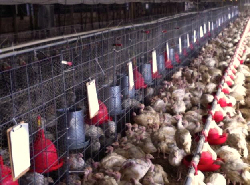



Salmonella Reduced in Turkey Field Trial with Original XPC
US - Original XPC helps reduce Salmonella in turkey field trial, reports Don McIntyre, PhD, PAS, Director for North American Poultry Research & Technical Service with Diamond V.Food safety is a critical topic for poultry producers and consumers. Adding Diamond V Original XPC™ to the feed of laying hens has demonstrated significant reductions in Salmonella species.
Initial studies were conducted in-vitro (using a lab model that mimics the poultry digestive tract)1. Then results were further validated with in-vivo (live bird) trials2,and finally with environmental (house swab) monitoring.
Research studies have been reported showing reductions in the prevalence (number of positives) and load (colony-forming units per gram) of S. typhimurium, enteritidis, arizonae, kentucky and heidelburg.
With a large set of data from laying hens, eggs and facilities, it was of interest to determine if commercial meat birds might demonstrate similar reductions in Salmonella when birds were fed Original XPC in the diet. Therefore, a simple screening trial was conducted with brooding turkeys (0 to five weeks) to indicate if Original XPC might be efficacious against Salmonella in the turkey barn.
Methods
Turkey hen poults were sourced from a known Salmonella-positive US breeder flock. On the day of hatch (day 0), poults were transported to a commercial brooding facility where birds were confined with brooder rings for the first seven days. Birds in half the rings received a standard commercial starter feed (Control) and the remaining rings were provided the same starter diet, with the addition of 2.5lb per ton Original XPC (XPC). The test diet was blended with the test article at the University of Arkansas research feed mill.
At day 7, birds of each treatment were weighed and assigned to one of 30 pens for the remainder of the brooding period (7 to 37 days). Pens were assembled in a row down the centre of the brooding barn. Pens were constructed of welded wire and poultry wire such that each secure pen measured 16 square feet, with one bell drinker and one hanging feeder per pen of 23 hens. Treatments were alternated in this design with Control birds in 15 odd-numbered pens and XPC hens in 15 even-numbered pens.

Salmonella Incidence
When hens were allocated to pens at day 7, 20 control birds were submitted to an independent laboratory for Salmonella determination. Of these 20 birds, Salmonella was cultured from 15 (75 per cent), confirming that test birds had been exposed to Salmonella.
Prior to moving from the brooding to grow-out facility at 37 days, all birds and remaining feed in each pen were weighed and six birds per pen (90 per treatment) were necropsied. The caeca from each bird sampled was removed and delivered to an independent lab for Salmonella testing3.
Results
Salmonella-positive birds were observed in 3 of the 15 Control pens (20 per cent)
No incidence of Salmonella (0 per cent) was identified from XPC birds in adjacent pens (Figure 1).

Due to the low recovery of Salmonella in test pens, Fisher’s exact test was used to test for statistical difference between treatments (P=0.11).
No statistical differences were observed for growth rate, feed conversion or mortality between days 7 and 37. Only two pens lost one bird each during this period.
Discussion
It is understood that Salmonella colonisation of the bird’s intestinal tract does not always progress in a linear fashion. It has also been established that while Salmonella may be ubiquitous, it may not always be captured and cultured. Therefore, quantifying Salmonella incidence is not often easy or definitive. The zero incidence of Salmonella observed in the turkeys fed Original XPC supports previous Original XPC study results (layer in-vitro and in-vivo) demonstrating reduced prevalence and load of Salmonella.
Conclusion
Results of this research suggest that adding Original XPC to the starter feed (2.5lb per ton) of turkeys can help reduce the incidence of Salmonella colonisation under naturally challenged conditions.
References
- Broomhead, J., D. Severson, J. Butler and J. Frank. 2012. Effects of a Saccharomyces cerevisiae fermentation product on volatile fatty acid production and growth of Salmonella in a complex fecal microbial population in vitro. Poult. Sci. 91 (Suppl.1):132.
- Ibukic, M., D. Trampel, T. Frana, C.M. Logue and J. Broomhead. 2012. Evaluation of Diamond V Original XPC for reducing cecal colonization by Salmonella Enteriditis in layer pullets. Poster #51P CRWAD meetings December 3, 2012, Chicago, IL.
- Whitbeck Laboratories, Inc., 1000 Backus Ave., Springdale, AR











